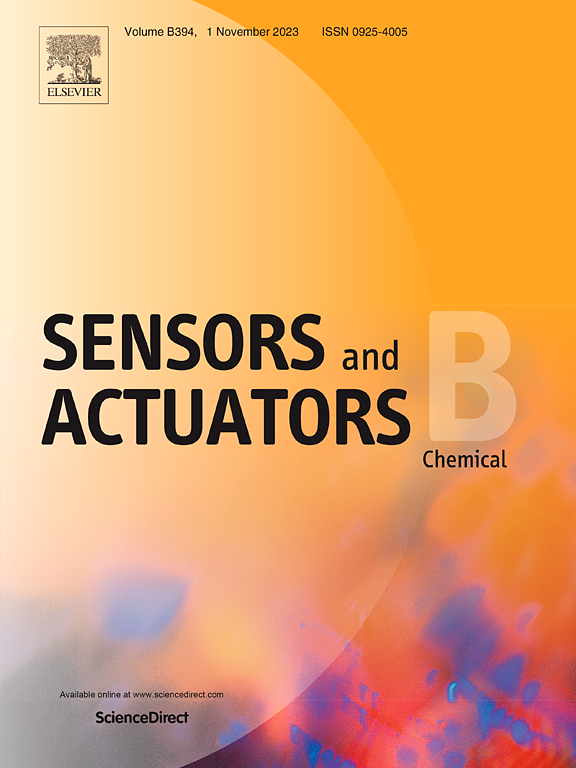基于电化学-表面等离子体共振传感技术的钝化膜纳米厚度原位监测
IF 8
1区 化学
Q1 CHEMISTRY, ANALYTICAL
引用次数: 0
摘要
由于其优异的稳定性,金(Au)经常被用作精密电子仪器中的关键连接器组件。然而,在复杂的环境中,如恶劣的海洋环境中,它仍然容易腐蚀恶化。在金表面形成的钝化膜对于防腐蚀至关重要,因此监测这种纳米级膜的结构和厚度对于确保金的安全运行至关重要。利用终端反射型光纤结构作为电化学(EC)传感的工作电极和表面等离子体共振(SPR)传感元件,实现了一种集成的双功能光纤EC-SPR传感器。该传感器能够在高盐度环境下检测各种恒定电压下Au钝化膜的形成,同时监测纳米级厚度的变化。根据极化曲线,在不同恒定电压下对Au进行钝化处理。在此过程中,实时监测EC信号和SPR共振波长,以跟踪钝化过程的进展。原位EC-SPR光谱揭示了金表面在形成过程中发生的动态变化。值得注意的是,随着电压的增加,钝化膜的厚度也相应增加,在恒定电压为0.4 V、0.6 V和0.8 V时,等效钝化膜厚度分别为10(±0.3)nm、14(±0.4)nm和18(±1.1)nm。这种集成光纤双功能传感器实现了纳米级Au钝化膜厚度的在线测量,为深海设备的腐蚀检测和安全运行提供了一种新的监测方法。本文章由计算机程序翻译,如有差异,请以英文原文为准。
In-situ nanoscale thickness monitoring of passive films based on electrochemical-surface plasmon resonance sensing technology
Gold (Au) is frequently employed as a critical connector component in precision electronic instruments due to its exceptional stability. However, it remains susceptible to corrosion deterioration in complex environments such as in harsh marine settings. The passive film that forms on the Au surface is vital for corrosion protection, making the monitoring of the structure and thickness of this nanoscale film essential for ensuring the safe operation of the Au. A terminal-reflective optical-fiber structure was utilized both as the working electrode for an electrochemical (EC) sensing and as the surface plasmon resonance (SPR) sensing element, thus creating an integrated dual-function optical fiber EC-SPR sensor. This sensor enabled detection of the formation of Au passive films at various constant voltages in a high-salinity environment, alongside monitoring changes in nanoscale thickness. Based on the polarization curves, the passivation of Au was conducted at different constant voltages. During this process, the EC signal and the SPR resonance wavelength were monitored in real time to track the passivation progression. The in-situ EC-SPR spectra revealed the dynamic changes occurring on the Au surface during the formation. Notably, as the voltage increased, the thickness of the passive film correspondingly increased, yielding equivalent passive film thicknesses of 10 (±0.3) nm, 14 (±0.4) nm, and 18 (±1.1) nm at constant voltages of 0.4 V, 0.6 V, and 0.8 V, respectively. This integrated optical fiber dual-function sensor facilitates online measurement of nanoscale Au passive film thickness, providing a novel monitoring approach for corrosion detection and the safe operation of deep-sea equipment.
求助全文
通过发布文献求助,成功后即可免费获取论文全文。
去求助
来源期刊

Sensors and Actuators B: Chemical
工程技术-电化学
CiteScore
14.60
自引率
11.90%
发文量
1776
审稿时长
3.2 months
期刊介绍:
Sensors & Actuators, B: Chemical is an international journal focused on the research and development of chemical transducers. It covers chemical sensors and biosensors, chemical actuators, and analytical microsystems. The journal is interdisciplinary, aiming to publish original works showcasing substantial advancements beyond the current state of the art in these fields, with practical applicability to solving meaningful analytical problems. Review articles are accepted by invitation from an Editor of the journal.
 求助内容:
求助内容: 应助结果提醒方式:
应助结果提醒方式:


